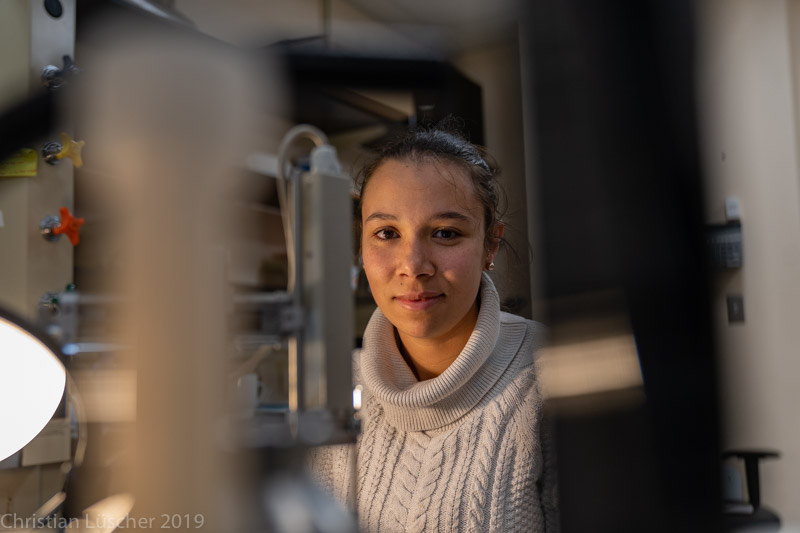Kaoutsar Nasrallah

Assistant Professor
Department of Biological Sciences
Fordham University
Larkin Hall - 300
441 E. Forham Road
Bronx, NY 10458
Email: [email protected]
-
BS in Chemistry, Biology and Physics, University of Paris-Descartes, 2010
MS in Cellular Biology, Physiology and Pathology, mention Neurobiology, University of Paris-Descartes, 2012
PhD in Neurosciences, University of Paris-Descartes, 2015
Postdoc, Dominick P. Purpura Department of Neuroscience, Albert Einstein College of Medicine, 2016-2021
Teaching Assistant, Dominick P. Purpura Department of Neuroscience, Albert Einstein College of Medicine, 2019
Research Associate, Dominick P. Purpura Department of Neuroscience, Albert Einstein College of Medicine, 2021-2023
-
The Nasrallah Lab explores the cellular mechanisms underlying basic brain function (e.g. memory) and brain disorders (e.g. epilepsy), primarily focusing on the role of tonic inhibition. Although inhibitory neurons represent only ~10-20% of the total neuronal population, they regulate virtually all aspects of cellular and circuit function. Most studies investigating the role of GABA, i.e. main inhibitory neurotransmitter in the central nervous system, have focused on phasic inhibition, which is mediated by synaptic GABAA and GABAB receptors. However, GABA also activates peri- and extrasynaptic GABAARs which can sense low concentration of ambient GABA and generate persistent tonic inhibitory currents. This unique form of inhibition, known as tonic inhibition, is crucial in controlling information processing and behavior. Nevertheless, very little is known about whether and how GABAAR tone is regulated in specific neurons during cognitive processes and brain disorders.
Depending on the cell type and the brain region, tonic inhibition is predominantly mediated by the non-synaptic δ- and α5-containing GABAARs (δ-GABAARs and α5-GABAARs, respectively). Interestingly, δ-GABAARs are particularly sensitive to steroids and can be modulated, for instance, in response to hormonal fluctuation and during epilepsy. In the hippocampus, a structure critically implicated in learning, spatial navigation, anxiety and epilepsy, functional δ-GABAARs are particularly enriched in both excitatory dentate granule cells (GCs) and inhibitory interneurons. Importantly, tonic δ-GABAARs play a crucial role in memory, stress-related behavior, epilepsy, schizophrenia and mood disorders. Yet, the precise role of δ-GABAARs-mediated inhibition in specific cell types remain elusive.
Our main goals are to determine:
- How δ-GABAARs-mediated inhibition is modulated by learning and diseases states, in specific cell types and brain regions
- The precise role of δ-GABAARs expressed by specific neurons in memory formation, epilepsy and neuropsychiatric diseases
To this end, we combine cutting-edge tools with different levels of analysis, from single cell, neuro-circuit levels to behavior. These approaches include well-established models of epilepsy and learning paradigms, markers of neuronal activity in vivo, cell type-selective conditional knock-out (KO) of δ-GABAARs, immunohistochemistry (IHC) and slice electrophysiology in mice. Knowledge generated by our projects can be crucial to develop future therapeutic strategies, using cell type-specific manipulations, which will likely have higher efficiency and fewer side effects than current treatments.
-
Gulfo MC, Lebowitz JJ, Ramos C, Hwang DW, Nasrallah K#, Castillo PE#. Dopamine D2 receptors in mossy cells reduce excitatory transmission and are essential for hippocampal function. BioRxiv 2023.05.05.539468. PMID: 37205586.
Nasrallah K, Berthoux C, Hashimotodani Y, Chávez AE, Lujan R, Gulfo M, Castillo PE#. Retrograde adenosine/A2A receptor signaling facilitates excitatory synaptic transmission and seizures. BioRxiv 2021.10.07.463512.
Nasrallah K#, Frechou A, Yoon Y, Persaud S, Goncalves T and Castillo PE#. Seizure-induced strengthening of a recurrent excitatory circuit in the dentate gyrus is pro-convulsant. PNAS. 2022 Aug 9;119(32). PMID: 35930664
Rodenas-Ruano A#, Nasrallah K, Lutzu S, Castillo M, Castillo PE#. Heterosynaptic NMDA Receptor Plasticity in Hippocampal Dentate Granule Cells. BioRxiv 2022.01.12.476040. BioRxiv
Berthoux C, Nasrallah K, Castillo PE#. BDNF-induced BDNF release mediates presynaptic LTP and is regulated by cannabinoids. BioRxiv 2021.12.30.474558. BioRxiv
Jensen KR*, Berthoux C*, Nasrallah K, Castillo PE#. Multiple cannabinoid signaling cascades powerfully suppress recurrent excitation in the hippocampus. PNAS. 2021 Jan 26;118(4). PMID: 33468648
K Nasrallah, L Therreau, V Robert, AJY Huang, TJ McHugh, RA Piskorowski and V Chevaleyre#. Routing Hippocampal Information Flow through Parvalbumin Interneuron Plasticity in Area CA2, 2019. Cell Rep. 2019 Apr 2;27(1):86-98.e3. PMID: 30943417
Hashimotodani Y*, Nasrallah K*, Jensen KR, Chávez AE, Carrera D, Castillo PE#. LTP at Hilar Mossy Cell-Dentate Granule Cell Synapses Modulates Dentate Gyrus Output by Increasing Excitation/Inhibition Balance, 2017. Neuron 95:928-943. PMID: 28817805
K Nasrallah, RA Piskorowski and V Chevaleyre#. Bi-directional interplay between proximal and distal inputs to CA2 pyramidal neurons, 2017. Neurobiol Learn Mem 138:173-181. PMID: 27353717
RA Piskorowski, K Nasrallah, K Stark, J Mukai, SA Siegelbaum, JA Gogos, V Chevaleyre#. Age-Dependent Specific Changes in Area CA2 of the Hippocampus and Social Memory Deficit in a Mouse Model of the 22q11.2 Deletion Syndrome, 2016. Neuron 89:163-76. PMID: 26748091
K Nasrallah, RA Piskorowski and V Chevaleyre#. Inhibitory Plasticity Permits the Recruitment of CA2 Pyramidal Neurons by CA3, 2015. eNeuro 0049-15.2015. PMID: 26748091
#corresponding author(s), *co-first authors